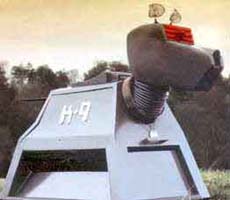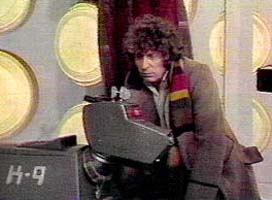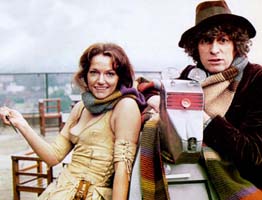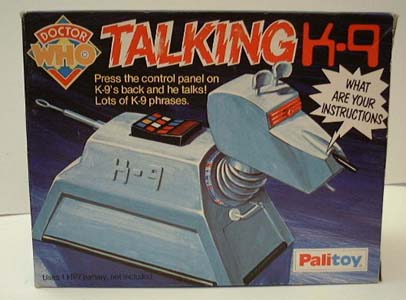|
Love it or hate it, K-9 became an integral component in
the Doctor Who legend. The character spanned 22 stories
over 3 years - although it didn't appear in all of these -
and was the subject of the programme's only televised spin-off,
K-9 and Company. Ty Power reports...
Although
Philip Hinchcliffe's tenure was highly regarded, it invited
criticism from certain quarters for its supposed exaggerated
horror content. So when new Producer, Graham Williams, entered
the frame in 1977 with Season Fifteen, it was with instructions
to generally reduce the level of violence. This initiated
a major change of direction. Whereas an occasional flippant
remark had not broken the suspense, now the show was very
much more light-hearted, giving many long-time viewers the
opinion Williams had gone from one extreme to the other, instead
of finding a suitable compromise.
 |
Into
this new period came a new companion that would ensure compatibility
with the hierarchy upstairs. K-9, created from a sketch by
Effects Designer Tony Harding, was introduced to us in that
season's second story, The Invisible Enemy, as an intelligent
computer dog, which is given to the Doctor by its owner/creator
Professor Marius when they part company. During the stories
which followed, the production team discovered that, both
in front and behind the camera, there were advantages and
disadvantages to the tin dog's existence. But was it more
of a help or a hindrance?
On the downside, the remote-control operated manoeuvrability
of the machine was severely restricted, making the movements
appear strained and ultimately inaccurate. In its earlier
stories, the motorised noise of its operation all but drowned
out the lines of the actors. Its speed, or rather lack of
it, was another downfall. It never failed to garner a good-natured
chuckle from me, when the Doctor said, "Lead the way, K-9."
The metal mutt would go whirring slowly down the corridor,
with the others shuffling almost on the spot behind it. When
the camera switched to the passageway's far end, K-9 would
be way out in front, the others hurrying to catch up!
 |
As
with the Daleks, its main drawback was its lack of compatibility
with altering terrain. Visual effects were often utilised
to make it seem as though it was traversing rough ground,
although they were not sufficiently professional to convince.
K-9 moved very little outside of smooth-floored structures
and, in the same way, it should never have been able to glide
freely through the TARDIS doors when the jutting base of the
police box required stepping over. It only needed to be lifted
from the ground or pushed over on its side, to be rendered
totally immobile.
Its
self-recharging powerpack proved unreliable at the best of
times. It made the character vulnerable, but only when the
plot of the current story demanded it. Similarly, the laser
cutter took mere seconds or long minutes to burn through the
same composite material door.
 |
K-9
was sucked into the steadily increasing level of additional
humour from both Graham Williams and Script Editors Anthony
Read and Douglas Adams, so that when Tom Baker's Doctor went
through a silly period, so too did K-9. The logical machine
mind was at times reduced to exchanging ridiculous banter.
I feel that the character would have been considerably more
convincing had more thought been applied at the conceptual
stage, and had they taken it more seriously. As it was, it
was invariably utilised as a last pitch means of escape for
the Doctor. During this period, the Doctor ceased thinking
and simply blew a dog whistle instead. Perhaps the BBC should
have immediately seized upon its popularity by producing K-9's
own programme much earlier, and maybe aiming it at a younger
audience.
On
the positive side, the character possessed many assets: It
had a huge capacity for stored knowledge (which was never
quite tested to its limit); equations and probabilities could
be calculated to several decimal points; a print out of data
could be produced upon request; it had the ability to scan
and identify most objects; sensory equipment meant approaches
could be detected; a retractable laser cutting tool was also
used for defence; and combining these together, it could be
dispatched to complete a complicated task without supervision.
 |
However,
what made K-9 so loveable to so many people was its characterisation.
Yes, it was possible for what amounted to a robot dog to possess
a character, and this should be accredited to John Leeson's
proficient voice overs. A hunk of electrical machinery should
not have developed as a character either, but it did. In its
first story, K-9 sputtered out ticker-tape strips and rarely
spoke. Further on, it replied to only direct questions, answering
in an emotionless, machinelike manner, constantly confusing
the Doctor's companion Leela. When K-9 elected to remain with
the Sevateem warrior on Gallifrey at the end of the season,
the Doctor cannily revealed a K-9 Mk II (one he made earlier!).
This one was much less introverted; I would even venture to
say it was a veritable chatterbox. It had gained a sense of
humour, and even exchanged banter at the height of danger.
Sometimes K-9 was left behind in the TARDIS, and this meant
that when certain information was required, or they needed
to be released from a scrape, it was present as a resourceful
back-up. As a regular companion, it was loyal and faithful,
and defended the Doctor and new companion Romana by any means
necessary, even if its own existence was in peril.
This
new semi-regular inclusion into Doctor Who proved very
successful, generating widespread newspaper publicity. There
is no doubt that it increased the viewing figures, at least
initially, and raised the numbers of younger children watching
the programme. This was proved by the storm of protest and
the 'Save K-9 Campaign' initiated when it was rested from
certain stories.
The
1981 K-9 and Company the spin-off pilot (titled A
Girl's Best Friend), in which Sarah Jane Smith received
a K-9 Mk III from the Doctor, was a competent 50-minute script
from the pen of Terence Dudley. However, although the BBC
regional transmitter fault undoubtedly affected viewing audiences,
the BBC had already missed the boat. The popularity of K-9
had waned.
Seventeen years later, there was a current attempt to revamp
the concept for its own series aimed at a younger, preteen
audience. Produced by Paul Tams and Bob Baker, the latter
of which along with Dave Martin were the original scriptwriters
for the character, much rested on the success or otherwise
of a new futuristic version of K-9 which was built and the
quality of reworked scripts. Although the project is still
said to be on the cards I remain pessimistic the idea will
work twice, being essentially too restrictive.
K-9
has had its day but, like it or loathe it, during those changeable
three years it was impossible to ignore.
Personally,
I couldn't abide the thing!

Return
to...

|